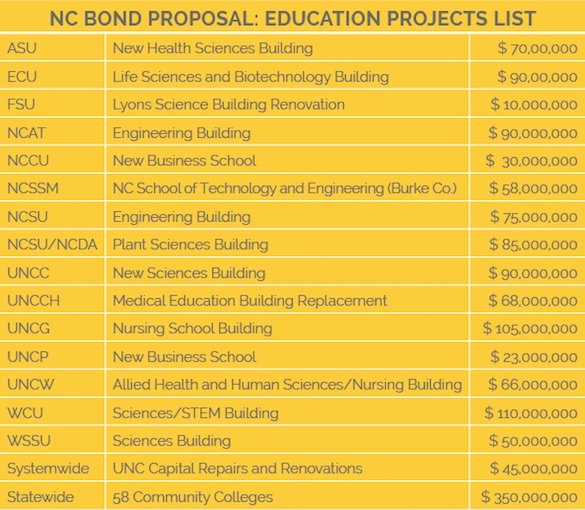Fifteen years have passed since North Carolinians overwhelmingly approved $3.1 billion in higher-education bonds in 2000.
With support from 70 percent of voters and a majority in all 100 North Carolina counties, the 2000 vote reaffirmed North Carolina’s historical commitment to public higher education.
The success of that effort – at the time, the largest higher-education bond issue ever floated – shows how much a well-designed, well-managed bond initiative can accomplish.
“The bond program’s projects met a vital need at a critical time,” according to the 2010 final report of the Higher Education Bond Oversight Committee. “It was visionary and well-executed, but significant needs remain.”1
The bonds leveraged more than $4 billion in new construction, renovations, repairs, and much-needed upgrades to aging university and community college campuses across the state. Even with the scale of the effort – 728 projects – the vast majority were finished on time and within budget.
The state’s history of low, responsible debt made bond financing a solid option for supporting infrastructure improvements. Ratings agencies kept an AAA score on the bonds, noting North Carolina’s moderate debt burden and “conservative fiscal operations.”
Having a stable, long-range source of funding allowed for better planning, project sequencing and more efficient construction, the Oversight Committee found.
Bond projects helped bolster the state’s construction and engineering firms, putting more than 33,000 people to work during the first three years of the program.2 At a time when the state was still recovering from a recession, the construction helped fuel growth in crucial industries.
The initiative focused on meeting real student needs – the majority of projects centered on expanded or renovated classroom space to serve a growing population of students.
“The program is ensuring that high quality resources, particularly in science and technology facilities, are available to students and researchers as North Carolina transitions from a manufacturing-based economy to one that is more knowledge-based and able to compete in the global environment,” according to a 2007 update to legislators.3
Upgrades to medical facilities, science labs, nursing schools, and engineering facilities were all major components, anticipating the state’s long-term needs in health, technology and science.
North Carolina has added more than 2 million people since then, with significantly more growth expected. And leaders are again making the case to voters to plan for important infrastructure needs with a $2 billion bond issue on the ballot March 15.
“I look at it as a reinvestment that the general public does enjoy,” Rep. Jason Saine, a Republican from Lincoln County, told the Lincoln Times-News. “The reinvestment in higher education both in the community college level and university level.”4
1 http://old.northcarolina.edu/reports/index.php?page=download&id=851, p. 4.
2 Ibid, p. 2.
3 http://www.ncleg.net/documentsites/committees/JLEOC/Reports%20Received/Archives/2007%20Reports%20Received/Higher%20Ed%20Bond%20Report%209-07.pdf, p. 1.
4 http://www.lincolntimesnews.com/2016/01/07/lincoln-county-legislators-advocate-for-bond-referendum/


Leave a Reply